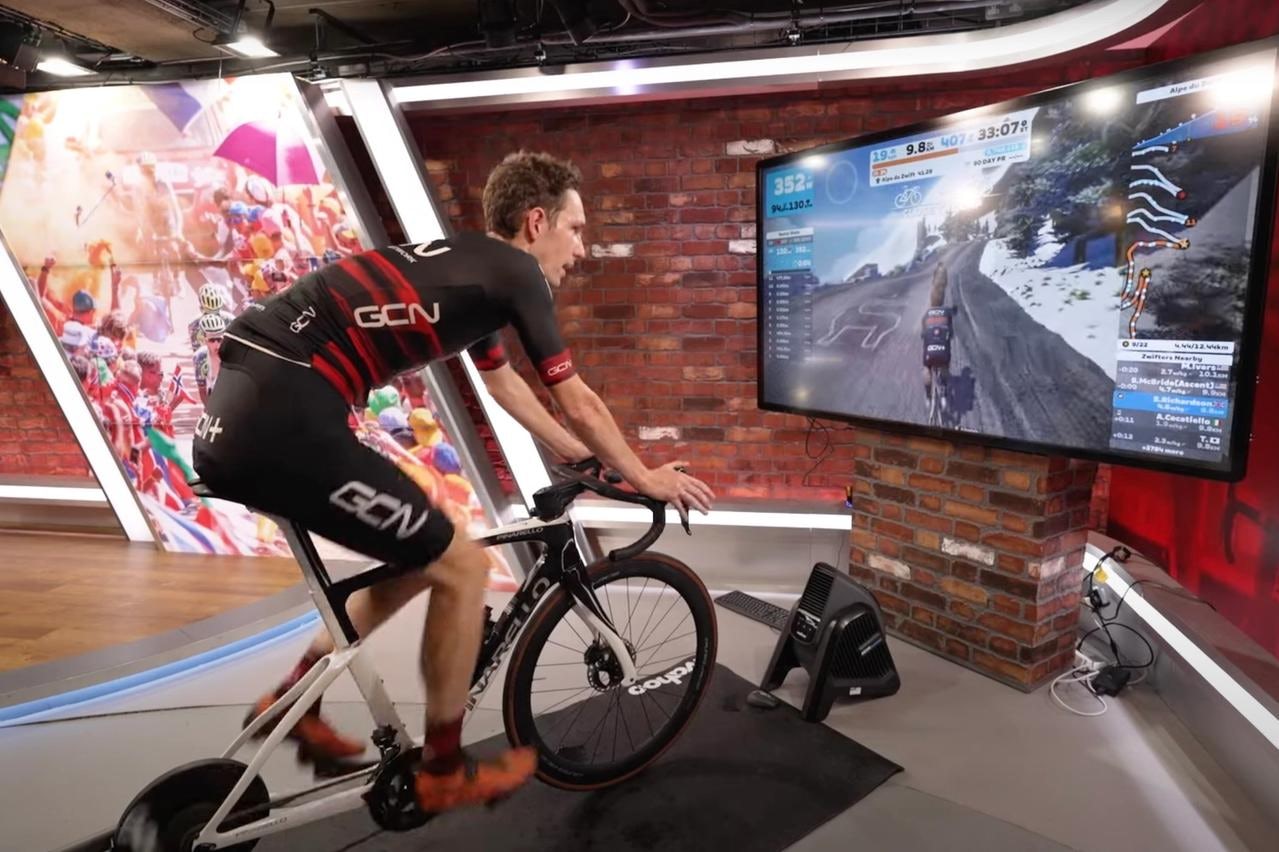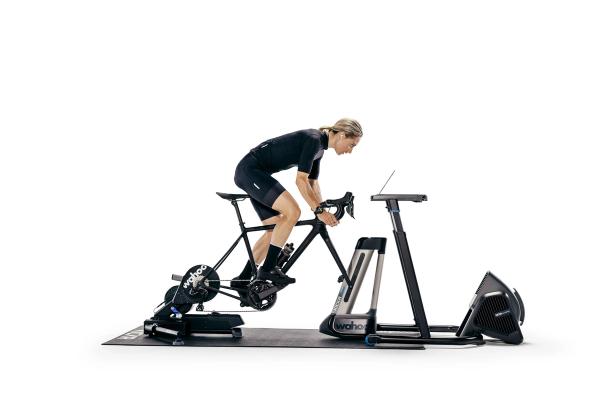Essential guide to indoor cycling 2024
Everything you need to know about cycling indoors, including smart trainer workouts, the best fitness apps for cyclists, indoor training accessories and equipment, plus indoor bike and pain cave set-up
Tom Hallam-Gravells
Online Production Editor
© GCN
Explore all of our how-to guides and advice articles about indoor cycling
Indoor cycling training has flourished in popularity over recent years and cyclists the globe around have turned to it as a convenient and time-effective way to train.
For those unfamiliar, turbo training, as it's also known, is a great way to escape the inclement weather throughout autumn and winter. It used to have a deserved reputation for being painfully boring. You had a choice between staring at a wall or watching your knees whir around. Sure, you could watch TV or have music on in the background, but that’s not particularly immersive or interactive.
Things have drastically changed in recent years and training has never been easier thanks to a wide range of apps that feature dedicated plans, workouts, and everyone’s favourite, the dreaded FTP test.
It’s not all about ‘no pain, no gain’ and for those who prefer a more social and interactive experience, platforms like Zwift also allows users to explore virtual worlds, go on group rides and even race - you can do everything type of riding possible, all from your living room on a turbo trainer or exercise bike.
Alongside these apps, there are now countless turbo and smart trainers available and the key to maximising your indoor cycling experience is finding the right set-up for your needs.
From being a very rudimentary training tool, indoor cycling has become pretty complicated, and there’s plenty to think about when getting started - but don’t worry! We’ve covered everything you need to know about turbo training to simplify your indoor cycling experience.
From turbo trainer set-up and the best indoor cycling apps to workout advice, here’s all the information you need to make the most of indoor cycling this autumn and winter.
Indoor cycling guide contents
Jump to:
- Indoor cycling for beginners: Turbo trainers and essential accessories
- How to get started indoor cycling: Set up your turbo trainer and pain cave
- Best apps for indoor cycling: Zwift, Wahoo and more
- FTP tests and creating training plans
- Indoor cycling workouts
Indoor cycling for beginners: Turbo trainers and essential accessories
When getting started, indoor cycling can be overwhelming. There’s so much tech and a bewildering number of fitness apps for cyclists. Not to mention all of the essential turbo training accessories you need, like tablet stands, a turbo trainer mat and fans.
Here are some pointers to help you navigate through the process.
What are the benefits of indoor cycling with a turbo trainer or smart trainer?
Let’s be honest, riding outside is great, so you may be wondering why so many cyclists can be found pedalling away in their living rooms.
- Indoor workouts are convenient: It all boils down to the convenience of training indoors. For a start, inclement weather can’t derail an indoor ride, which can’t be said for outdoor riding for much of the year.
- Time-efficient training: Then there’s the matter of time, which many cyclists have a sad lack of. Everyday life can make it hard to find time to ride, but things become much simpler with a turbo trainer. You can simply jump on and ride, without having to worry if you’ll get back in time.
- Training indoors is simple and easy to follow: Turbo training can also be a more efficient way to train, as you won’t be interrupted by traffic, stop signs or any other road furniture.
Read more: Indoor cycling vs night riding: Which is better for winter training?
How to choose the right turbo trainer for beginners: Wheel-on, direct drive, rollers or static bike
Once you’ve made the decision to start indoor cycling, you’ll need to invest in a turbo trainer. That seems simple enough, except there are a surprising number of turbo trainers available and it’s not just a matter of buying the cheapest or first one that you find.
The first decision is whether you want a turbo trainer, rollers or a static bike. Turbo trainers are by far the most common as they essentially allow you to turn your bike into an indoor trainer, either through a direct-drive or wheel-on system. For a wheel-on set-up, the rear wheel of your bike rests on a roller which generates the resistance and then the trainer clamps the rear axle to keep the bike in place. A direct-drive trainer differs slightly as it has a cassette built in which generates the resistance. The rear wheel therefore has to be removed from a bike so that it can be connected to the on-trainer cassette, before everything is secured together using a thru axle or quick release skewer.
The main alternative is a static/exercise bike, although these tend to be a little more expensive. This isn’t a problem if you train indoors regularly, but most beginners won’t be at a stage where they can justify paying the price for an indoor bike.
Finally, rollers are still used by some cyclists but they’re much less popular. That’s partly because it takes lots of concentration to stay upright while riding, which is why they’re generally used for warm-ups and cooling down at events.
More advice on choosing the right bike trainer:
- Wheel-on, direct-drive or rollers? How to choose the right turbo trainer for you
- Turbo trainer vs exercise bike: Which is better for indoor cycling?
Smart vs ‘dumb’ indoor trainers
If, like the majority of cyclists, you choose a turbo trainer, your next choice is between a smart or ‘dumb’ version.
There are now a wide range of apps available that allow you to do everything from exploring virtual worlds and going on group rides to racing. If you want to take full advantage of these possibilities, you’ll need a smart trainer. These allow an app to directly control the resistance so, if you’re using Zwift for example, the trainer will mimic the virtual road you’re riding in. If you’re climbing, the resistance will go up, and when descending it will go down. It will even vary depending on the gradient.
Dumb trainers don’t have this functionality. You can still often use them with apps like Zwift, but they can’t replicate the virtual world you’re riding in. Instead, you will need to manually change the resistance.
Read more:
Essential indoor cycling accessories
All you need to train indoors is a bike and an indoor trainer, but your riding experience will be much more enjoyable with a few key accessories.
A fan is the most important accessory of all. Unlike riding outdoors, there’s no airflow to cool you down and regulate your temperature. That’s why a fan is essential and, if possible, use two for maximum cooling effect.
Other useful accessories include a stand or holder for your devices, which you’ll inevitably need when you take advantage of the numerous indoor training apps (more on this later).
Even with fans blasting cool air in your face, turbo training is sweaty work, so a towel will come in handy. It can also be used to wipe any sweat off your frame, but it’s best to use a dedicated sweat guard. There are plenty of myths about turbo trainers wrecking bikes, but in reality sweat is the biggest threat when riding indoors as it can erode components.
A front wheel stand and indoor training mat can also be useful.
Learn more about the indoor cycling equipment and accessories you need:
- Essential turbo training equipment: Everything you need to start training indoors
- Do you really need a fan for indoor cycling?
How to get started indoor cycling: Set up your turbo trainer and pain cave
You’ve got everything you need, now there’s the matter of setting it all up. Cyclists take lots of pride in their ‘pain caves’, which are their indoor cycling set-ups. However, an indoor cycling set-up doesn’t need to be fancy, simply functional.
That being said, it will be much easier and more convenient if you have a permanent space set aside and, ideally, can leave a bike permanently set up on the trainer.
If you can’t, think carefully about where you’ll set up your trainer. You’ll need somewhere with plenty of space. Try to pick a spot where you won’t need to move other furniture around to make space, as this will be time consuming whenever the time comes to set everything up again. It should also ideally be close to where you store your trainer, as they can be quite heavy to lug around.
Then there’s the matter of noise pollution. It’s the biggest drawback to training indoors and it can be disruptive to the rest of your family or friends, who may become a little grouchy with you after a while. That’s why a far away corner from everyone else is usually a good spot.
Read more about indoor cycling set-ups:
- The ultimate pain cave: How to set up your training space for the best indoor cycling experience
- How to get started with indoor cycling training
- Permanent vs temporary indoor cycling set-up: Which pain cave is best?
Turbo training maintenance issues and troubleshooting
Technology can be a pain and indoor trainers aren’t immune to this. Every so often, you may run into a technical hiccup. We hate to state the obvious here, but issues can often be remedied by restarting the trainer or the connected app.
If not, your trainer or the connected app may need updating.
For more issues that you’re struggling to resolve, it’s best to contact the manufacturer of your trainer directly, who should help to troubleshoot the problem.
Learn more about how to maintain and look after your turbo trainer:
Best apps for indoor cycling: Zwift, Wahoo and more
If you still think turbo training is a relatively boring endeavour, think again. Modern apps have revolutionised the way we ride indoors, introducing lots of functionality that makes the indoor cycling experience engaging, entertaining and enjoyable. The only problem is, there are so many apps to choose from.
How to choose the right indoor cycling app
Apps come in all different shapes and sizes, so avoid simply opting for the cheapest. You want to have fun when riding indoors, so think carefully about what you want to achieve and what type of riding you’ll be doing.
The latter may sound a bit pointless, after all, how many different types of riding can you do indoors? A lot more than you may think. Across the spectrum of apps, indoor cycling can now essentially replicate every form of outdoor riding.
You can explore virtual worlds, many of which are based on real-world roads, race, go on group rides, ride alongside the pros, or follow training plans and workouts. There really is something for everyone.
More information on indoor cycling apps: Indoor training apps all cyclists should know about
Zwift: Explore virtual worlds, race and more
Zwift is currently the largest and most popular indoor training app. Hop on at any time of the day and you will find thousands of cyclists cruising around its virtual roads. These roads cover thousands of kilometres across 12 different worlds. Some of these are based on real-world routes, like Zwift’s replica of Alpe d’Huez, known as Alpe du Zwift.
Through the online platform, you can also race, go on group rides or try out a training session from its large library of workouts.
More Zwift tips and advice:
- Zwift training challenge: How fit can you get using a turbo trainer?
- How to use Zwift and a smart trainer to lose weight
- A beginner’s guide to Zwift
- 10 mistakes to avoid on Zwift
- What can you do on Zwift in one hour? Train, race, Watopia, FTP test and more
- Getting started with Zwift indoor training
- Zwift routes & worlds - a complete guide
- How realistic is Zwift and can it really help you prepare for reality?
Maximise your training through Wahoo X
Wahoo X, formerly Wahoo Systm, has undergone some changes in recent teams that saw the cutting of RGT from its line up. RGT was similar to Zwift but Wahoo stripped it away at the end of 2023 to refocus the Wahoo X platform more towards training.
The platform allows you to either use stock or create your own custom training plans, using a vast library of workouts. Unlike other training apps, it doesn’t rely on FTP tests, instead using its Four Dimensional Power profile. This puts users through four tough tests that Wahoo believes provides a more rounded profile for a rider, which in turn should make it easier to tailor training plans to your specific needs.
More articles on Wahoo’s app and smart trainers:
- Which Wahoo smart trainer is best for you?
- Guide to Wahoo SYSTM: Fitness tracking and workouts for your smart trainer
- Wahoo releases two new indoor trainers: Kickr Move and Kickr Bike Shift
Other indoor cycling apps
There are lots of other indoor cycling apps out there too, from TrainerRoad to FulGaz and Rouvy. Many of them feature free trials when you first sign up so that you can test around before settling on the right one.
Click the links below for more details on the different indoor cycling apps:
- Zwift
- Wahoo X
- MyWhoosh
- Strava
- Rouvy
- TrainerRoad
- Training Peaks
- YouTube
- TrainerDay
- Bkool
- Peloton
- Kinomap
- CycleGo
- Velo Reality
Best FTP tests for cyclists and creating training plans
Training indoors can be lots of fun, but for many cyclists it is still about making serious fitness gains and boosting that all-important FTP (functional threshold power) number - improving fitness and having fun don’t have to be mutually exclusive, either.
Here are some top tips to maximise your indoor training, leading to maximum fitness gains and a higher FTP.
What does FTP mean in cycling?
FTP, short for functional threshold power, is the maximum amount of power a rider can sustain for one hour, measured in watts. It is regarded as one of the best benchmarks of a cyclist’s fitness by many, including most indoor training apps which base their training sessions and plans around it. Once established, it can be used to calculate the different training zones - these are different levels of intensities that you will target during training.
Read more cycling FTP articles:
- Why are cyclists obsessed with FTP numbers, and is it actually useful?
- Getting the most out of your smart trainer with training zones
How do cyclists calculate FTP?
While it’s possible to complete an FTP test outdoors, it is more efficient indoors as you won’t have to contend with traffic or undulating terrain, all of which could affect the result.
One-hour FTP test
There are multiple ways to test for your FTP, starting with a one-hour all-out test. The goal of this is simple: ride as hard as you can for one hour, sustaining the highest possible power. Whatever power you average for the hour is your FTP.
20-minute FTP test
As the one-hour test can be seriously hard to complete, plus difficult to pace, a 20-minute alternative is popular. This follows the same principle, except your FTP will be 95% of the power you hold for the 20 minutes.
FTP ramp test
Since the introduction of turbo trainers, and specifically smart trainers, ramp tests have emerged as the go-to for many cyclists. Taking the pacing factor out of the equation, these ramp up at one-minute intervals, starting out easy before slowing building up. It’s easy to become lulled in at the start but the pain and suffering will kick in, at which point it's time to grit your teeth and hold on for as long as possible. Once you stop, the training app will calculate your FTP.
All three of these methods are available across most apps, including Zwift, Wahoo and TrainerRoad.
Read more:
- How to do an FTP test to measure your cycling fitness
- Should we all be doing ramp FTP tests?
- 20-minute, one hour or ramp test: Which FTP test is best?
How to build an indoor cycling training plan to improve FTP
Building a training plan can be daunting but indoor training apps simplify the process.
Some, like Wahoo and TrainerRoad will help to create plans for you. For the former, this will include strength training, yoga and mental health exercises, as well as cycling workouts.
Others, such as Zwift, are home to a wide range of workouts, plus existing training programmes, including a selection provided by pros - there’s even a GCN range of workouts.
More indoor cycling training plan advice:
- How to make your own training plan
- Polarised training: How to build cycling endurance without the time penalty
- Mastering nutrition and recovery: what should you eat while following an indoor cycling plan?
- How to incorporate strength training into an indoor cycling plan
Indoor cycling workouts and online spin classes
If you need a little extra indoor training inspiration, why not try out GCN’s range of indoor workout videos?
Each video is guided by a GCN presenter - including Manon Lloyd, Conor Dunne and James ‘Hank’ Lowsley-Williams - and the training intensities are based on perceived effort, making them accessible to every type of cyclist. So, whether you’re a beginner to indoor workouts, need an endurance boost, or are trying to raise your VO2 Max, we have a workout for you.
Workouts to boost VO2 Max and anaerobic ability
Cycling is fuelled either aerobically or anaerobically. Aerobic exercise uses oxygen and is sustainable for longer periods of time, while anaerobic exercise uses glucose. The ceiling of a rider’s aerobic capacity, at which point they pass into an anaerobic state, is known as the VO2 Max.
It’s a really important number and targeting it can lead to lots of benefits, helping you to ride harder for longer periods of time.
Many studies have shown that the best way to improve VO2 max is through HIIT workouts, which can also boost your anaerobic ability too.
Explore GCN’s HIIT workouts targeting VO2 Max and anaerobic ability
Improving cycling endurance through sweet spot training
Contrary to some popular beliefs, you can improve your endurance by riding indoors. For some, this will be through polarised training, a popular method that is a favourite of Tadej Pogačar’s coach Inigo San Millán (if it’s good enough for him, it’s good enough for us). It involves splitting your training between low and high-intensity training, usually with a 80%/20% split.
Alternatively, sweet spot training is also popular. Sweet spot is a training zone at around 85-95% of a rider’s FTP. It is a relatively hard effort, but one that should be sustainable for over an hour.
Learn more about sweet spot training and explore GCN’s favourite sweet spot workouts.
More endurance training for cyclists: The best ways to build endurance with an indoor trainer
Benefits of indoor cycling workouts shorter than 30 minutes
Life often gets in the way of cycling, leaving little time to spin the pedals. Things are made worse by a common misconception that short workouts aren’t very effective, leading time-strapped cyclists to ignore shorter sessions.
In reality, regular, short indoor workouts can have big benefits, but the key is to be consistent. Even if you only have less than 30 minutes, it is still plenty of time to cram in a high-quality workout.
Read more: GCN's best indoor cycling workouts: FTP, VO2, HIIT & Endurance
Best turbo and smart trainer news and articles from GCN
From the price of a smart trainer to app subscription costs, follow all of the latest indoor cycling news below:
- Turbo trainers pro cyclists use
- Pedal power: The exercise bike that can charge your phone and run your fridge
- Indoor Training app Rouvy offers huge savings with new subscription model
- Zwift makes indoor training more accessible with new Hub One turbo trainer
- Wahoo set to offer Zwift subscriptions with RGT set to close
- Rouvy announces new routes and features ready for turbo training season
- Zwift Hub increases in price in line with new features and Watopia expansion
- Wahoo drops price of Kickr Core indoor trainer
- Zwift to be replaced by MyWhoosh for cycling E-sports World Championships
- Zwift Games aims to be the 'biggest cycling esports competition to date
- Zwift launches new annual subscription with cost savings over monthly membership
Want to get more from your training or need some inspiration? Explore:
- GCN’s latest bike tech features
- Fitness tips, health and cycling science
- Interviews with pro cyclists
- GCN’s presenter challenges and cycling adventures









.jpg?w=600&auto=format)



.jpg?w=600&auto=format)